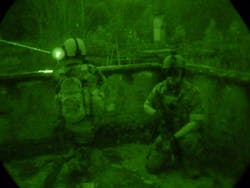Military researchers ask industry to develop infrared imaging sensors based on optomechanical technology
ARLINGTON, Va. – U.S. military researchers are asking industry to develop new kinds of thermal imaging and infrared (IR) detection based on optomechanical sensors -- or those that can modulate light propagation.
Electro-optical scientists at the U.S. Defense Advanced Research Projects Agency (DARPA) in Arlington, Va., issued a broad agency announcement (HR001122S0055) earlier this month for the Optomechanical Thermal Imaging (OpTIm) Technical Area (TA) 1 project.
The OpTIm program seeks to demonstrate a new class of room-temperature integrated optomechanical medium- and long-wave IR detectors that could bridge the gap between room-temperature microbolometers and cryogenic quantum-limited IR photodetectors.
The project will explore intrinsic infrared-sensitive materials, nano-assembled metamaterials and heterostructures that combine enhanced IR-absorption, multispectral or polarization-sensitive IR capabilities with high-Q optomechanical resonator integration and quantum-limited optical readout.
OpTIm will validate the essential elements of this IR detection concept, which consist of three elements:
-- spectrally tailored narrowband, multispectral, or polarization-sensitive IR absorption in high-Q thin-film resonators or heterostructure membrane resonators;
-- IR-induced frequency shifts in the resonator eigenmodes that can be determined rapidly because of high intrinsic quality factors, low thermomechanical noise, low thermal mass, and low fractional frequency instability of these resonators; and
-- all-optical detection of these frequency shifts at or near quantum-limited precision by harnessing visible or near-IR photodetection technology.
Such all-optical protocols potentially can circumvent issues of readout integrated circuit (ROIC)-induced noise sources, fabrication incompatibilities, or related issues that have hampered conventional microbolometer technology. OpTIm also aims to establish fundamental sensitivity, bandwidth, noise, and performance limits of this new modality of IR detection.
Infrared (IR) detectors involve applications like night vision, biochemical spectroscopy, automation, and climate science.
Current IR detection techniques rely either on photodetection or thermal detection. While IR photodetectors can achieve quantum levels of sensitivity, they require cryogenic cooling to mitigate dark current and other noise sources.
In contrast, thermal detectors such as microbolometers can operate at room temperature but offer far lower performance levels than IR photodetectors, resulting in a significant performance gap in IR detection technology between uncooled thermal detectors and cryogenically cooled photodetectors.
OpTIm is a 60-month program broken into two 30-month phases. The first phase will focus on the validating the OpTIm device concept by developing sensor materials that combine low-noise, high-Q optomechanical properties with tunable, narrowband, or multispectral IR-sensitive absorption characteristics.
The project's first phase also will demonstrate IR-induced modification of resonator eigenmodes in a single-pixel detector with effective area smaller than 100 square microns, and characterize the detector's IR sensitivity and IR-spectral characteristics.
The second phase, which will depend on a successful first phase, will demonstrate all-optical interrogation of the optomechanical detector and optical readout of IR signals from the single-pixel detector developed the project's first phase.
It also will tune, optimize, and characterize detector sensitivity, dynamic range, signal bandwidth, spectral and polarization characteristics, Allan variance of the optomechanical resonator spectrum, and performance metrics for the optical readout.
This broad agency announcement addresses technical area one (TA1) of the OpTIm program, which focuses on IR sensitivity, signal bandwidth, and the spectral characteristics of medium- and long-wave detectors.
Companies interested should submit full proposals no later than 1 Nov. 2022 to the DARPA BAA Website at https://baa.darpa.mil. Email questions or concerns to DARPA at [email protected]. More information is online at https://sam.gov/opp/ad090fdd991d4478b72efd30f37d89d0/view.

John Keller | Editor-in-Chief
John Keller is the Editor-in-Chief, Military & Aerospace Electronics Magazine--provides extensive coverage and analysis of enabling electronics and optoelectronic technologies in military, space and commercial aviation applications. John has been a member of the Military & Aerospace Electronics staff since 1989 and chief editor since 1995.

